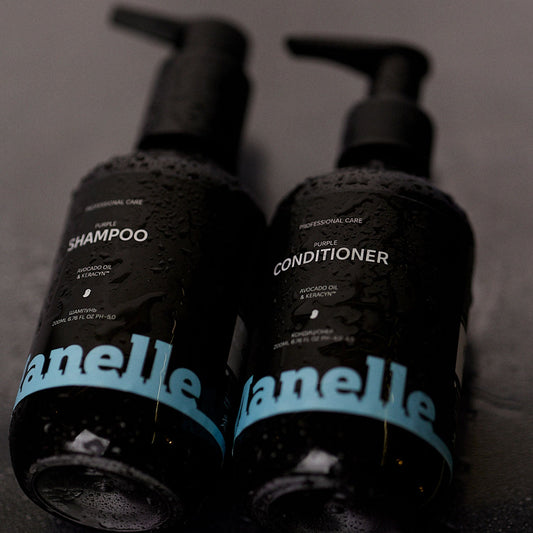
Shampoo for oily hair: how to defeat excessive shine
Oily hair is a problem that worries millions of people, regardless of age and gender, turning daily care into a real challenge. When in the morning the hair looks fresh and voluminous, but by lunchtime the roots become greasy and lifeless, this is a signal that the sebaceous glands are working in an enhanced mode. The right shampoo for oily hair is the key to solving this delicate problem. In this material, we will take a detailed look at which components really work, how to distinguish a quality product from a marketing wrapper, and what application techniques will help to prolong the freshness of the hairstyle for the maximum period.
Shampoo for oily hair: why hair gets oily quickly
Oily hair is a consequence of overactivity of the sebaceous glands located in the scalp. Sebum, a natural fatty substance, performs a vital function: it protects hair follicles from drying out, creates a barrier against pathogenic microorganisms, and maintains hair elasticity. Normally, this mechanism works in a balanced manner, but when the glands begin to produce an excessive amount of sebum, the hair loses volume, looks untidy, and acquires an unpleasant greasy shine.
The causes of increased fat are diverse. Hormonal fluctuations are one of the most powerful triggers, which is why the problem often worsens during adolescence, pregnancy, or menopause. Stress and sleep disorders affect cortisol, which directly regulates the activity of the sebaceous glands. A diet with an excess of simple carbohydrates, trans fats, and dairy products can also provoke increased fat formation by affecting the body's insulin response.
Paradoxically, it is often the wrong care that becomes the main culprit of the problem. Aggressive shampoos with harsh surfactants strip the scalp of its natural protection, and the body in response begins to produce even more sebum - this is a protective reaction. Hot water when washing, frequent use of thermal tools, applying heavy styling products to the roots create a vicious circle. Understanding these mechanisms helps to build the right strategy to combat oiliness.

Key Ingredients: What the Perfect Shampoo for Oily Hair Should Contain
A shampoo for oily hair should gently cleanse the scalp, regulate the work of the sebaceous glands and not disrupt the natural balance. Zinc is one of the most effective seboregulating components, which normalizes sebum production at the cellular level. It is often presented in the form of zinc pyrithione or zinc gluconate. Nettle extract is a time-tested ingredient that has astringent properties and helps control the activity of the glands.
Mint, eucalyptus and tea tree create a cooling and antiseptic effect, normalize the microflora of the scalp. These components are especially useful if oiliness is accompanied by itching or a tendency to dandruff. Clay - kaolin, green or blue - acts as a natural absorbent, absorbing excess oil even during washing. Salicylic acid in low concentrations provides a light peeling effect, cleanses pores and prevents their clogging.
Components to avoid in the composition:
- Aggressive sulfates (Sodium Lauryl Sulfate) — can cause a rebound effect
- Heavy silicones (Dimethicone, Cyclomethicone) — create a film that weighs down the hair
- Oils in the first third of the composition - you definitely don't need the extra fat content
- Parabens and synthetic dyes — can irritate sensitive scalps
- High concentrations of proteins and keratin make hair heavy
Mild surfactants, such as sodium cocosulfate or lauryl glucoside, create sufficient foam for cleansing, but do not overdry the skin. B vitamins, in particular B6 and B5, support scalp health and help regulate sebaceous glands. Green tea extract has antioxidant properties and helps normalize cell metabolism.
How to read a label correctly: deciphering marketing
The beauty industry is a master of the art of packaging, and often the bright promises on the label do not correspond to the actual contents of the bottle. The first rule is to always read the composition, not the advertising slogans. Ingredients are listed in descending order: the closer to the beginning of the list, the higher the concentration. If the declared "natural extracts" are at the end of the composition after the preservatives, their effectiveness is minimal.
The phrase "sulfate-free" does not always mean gentle cleansing - the manufacturer may use other aggressive surfactants. The label "for daily use" often indicates a very mild formula that may not be effective enough for truly oily hair. "Organic" or "natural" shampoo does not have any regulatory standards - it may be a simple marketing ploy. Look for certificates: COSMOS, ECOCERT, BDIH guarantee a certain percentage of natural ingredients.
The pH balance of a shampoo is critically important, although it is rarely indicated on the packaging. The optimal indicator for oily scalp is 4.5-5.5, that is, slightly acidic. It is in this range that sebum regulation works most effectively. If the manufacturer does not indicate pH, this can be a red flag. The volume of the bottle also matters - concentrated formulas in small bottles often turn out to be more economical than large, but diluted products.
Washing technique: the correct algorithm for maximum effect
Even the most advanced shampoo for oily hair will not give results if the application technique is incorrect. Before washing, comb your hair thoroughly - this will help remove dust, styling residues and distribute sebum along the length. Wet your hair with warm (not hot!) water for 30-40 seconds - this opens the cuticle scales and prepares the skin for cleansing. The temperature should be comfortable for the palm of your hand, approximately 36-38 degrees.
For shampoo, take a coin-sized amount (depending on the length), rub in your palms until a light foam forms. Apply only to the roots and scalp, using your fingertips (not your nails!) in circular massage movements. Imagine that you are gently "kneading dough" on your head. This technique stimulates blood circulation, but does not injure the skin. The massage should last at least 2-3 minutes - this is the time when the active ingredients penetrate the pores and work.
The length of the hair does not need to be intensively soaped - the foam that flows from the roots during rinsing is enough. The first rinse removes surface dirt, the second provides deep cleansing. For oily hair, double washing is not a luxury, but a necessity. Be sure to rinse the final rinse with cool water - this closes the cuticle, adds shine and reduces stimulation of the sebaceous glands. If the water in the region is hard, a final rinse with water with a tablespoon of apple cider vinegar will neutralize the alkali.

Frequency of washing oily hair: finding the golden mean
One of the most difficult aspects of caring for oily hair is determining the optimal frequency of washing. The common advice to "wash less often so as not to stimulate the glands" does not work for everyone and can even make the situation worse. If your hair is intensely oily, walking around with a stale head for several days is not only aesthetically unpleasant, but also harmful: dirt accumulates, the skin microflora is disturbed, dandruff or inflammation may appear.
A realistic approach is to start with your current frequency and gradually try to increase the intervals. If you are used to washing your hair every day, try stretching it to 1.5 days, using dry shampoo on the evening of the first day. After 2-3 weeks, your scalp may adapt and start producing less sebum. This process requires patience - do not expect instant results. Some people are genetically predisposed to high gland activity, and washing daily is the norm for them, not a problem.
The optimal scheme for different degrees of fat content:
- Moderate oiliness: wash every other day using a specialized shampoo
- High oiliness: daily washing with a specialized product, alternating with a mild shampoo
- Combination type (oily roots, dry ends): wash every other day with a focus on the roots, conditioner only on the lengths
- Oiliness after sports: additional washing with water without shampoo or dry shampoo
- Transition period: gradually increase intervals by half a day every 2 weeks
Listen to your body and hair. If your skin itches, dandruff appears, or you feel uncomfortable, it's a signal that your current regimen isn't working. There is no universal formula, each person is unique. The main thing is to maintain cleanliness and comfort, without going to extremes in either direction.
Additional products for shampoo for oily hair: building a comprehensive care system
Shampoo for oily hair is the foundation of care, but not the only element of a successful strategy. Conditioner or balm should definitely be in your arsenal, even if it seems that moisturizing will make your hair even oilier. The secret is in the right choice and application: choose light, silicone-free formulas marked "for oily hair" and apply exclusively to the length, retreating at least 5-7 centimeters from the roots. This will protect the ends from drying out.
A scalp tonic or lotion becomes a powerful helper in regulating oiliness. Such products contain concentrated doses of zinc, plant extracts, acids. They are applied to clean, dried scalp after washing, do not rinse off. Using 2-3 times a week gives a cumulative effect - after a month you will notice that your hair stays fresh longer. Scalp peeling once every 7-10 days deeply cleanses pores, removes dead cells and allows shampoo to work more effectively.
Hair masks for oily hair should be light and not heavy. Clay masks are applied to the roots before washing, they absorb excess sebum. Nourishing masks with proteins and vitamins are applied only to the lengths and ends, so as not to provoke additional greasiness. Leave-in products - sprays, fluids - choose those that are designed specifically for fine and oily hair, with a minimum oil content. They add shine and make combing easier without weighing it down.

Grooming mistakes: what ruins your efforts
The most common mistake is using too much shampoo, believing that more lather means better cleansing. In fact, excess product is difficult to completely rinse off, and residue builds up on the scalp and creates a greasy and heavy feeling. Stick to the recommended dosage - literally the size of a walnut for medium length hair. The second wash can be done with less, as the hair is already partially cleansed.
Massaging with nails instead of fingertips injures the scalp. Micro-scratches become a gateway for bacteria, provoke inflammation and, as a protective reaction, increased sebum production. Your movements should be confident but delicate. Rinsing off shampoo too quickly also reduces its effectiveness - the active ingredients need time to act. At least 2 minutes for massage plus 30-40 seconds for rinsing off each lather.
The wrong drying and styling temperature significantly worsens the condition of oily hair. A hot hair dryer held close to the roots stimulates the sebaceous glands - a couple of hours after styling, your hair will look greasy again. Hold the hair dryer at a distance of at least 20 centimeters, use medium temperature and always finish with a cold blow. Frequent touching of hair with hands during the day transfers oil and bacteria from the palms to the roots - try to control this habit.
Long-term strategy: from symptoms to causes
External care gives a quick cosmetic effect, but for a lasting result it is important to work with internal factors. Nutrition directly affects the condition of the skin and hair. Reduce the consumption of simple carbohydrates (sugar, white bread, pastries), dairy products and saturated fats - these products can increase the activity of the sebaceous glands due to their effect on insulin and IGF-1. Increase the amount of omega-3 fatty acids (fatty fish, flaxseeds, walnuts) and vegetables.
Hydration is critical for all processes, including regulating the sebaceous glands. Paradoxically, dehydration can cause increased oiliness — the body tries to compensate for the lack of water by increasing sebum production. Drink at least 1.5-2 liters of clean water per day, especially if you exercise actively or live in a dry climate. Sleep quality and stress management are also directly related to hormonal balance.
Sometimes, excessive hair oiliness is a symptom of internal disorders: hormonal imbalance (thyroid problems, polycystic ovary syndrome), deficiency of B vitamins or zinc, scalp diseases (seborrheic dermatitis). If even after 2-3 months of proper care and lifestyle correction, the situation does not improve, you should consult a trichologist or endocrinologist. Hormone analysis and hair mineralogram will help identify the true cause of the problem and choose the right treatment.

















